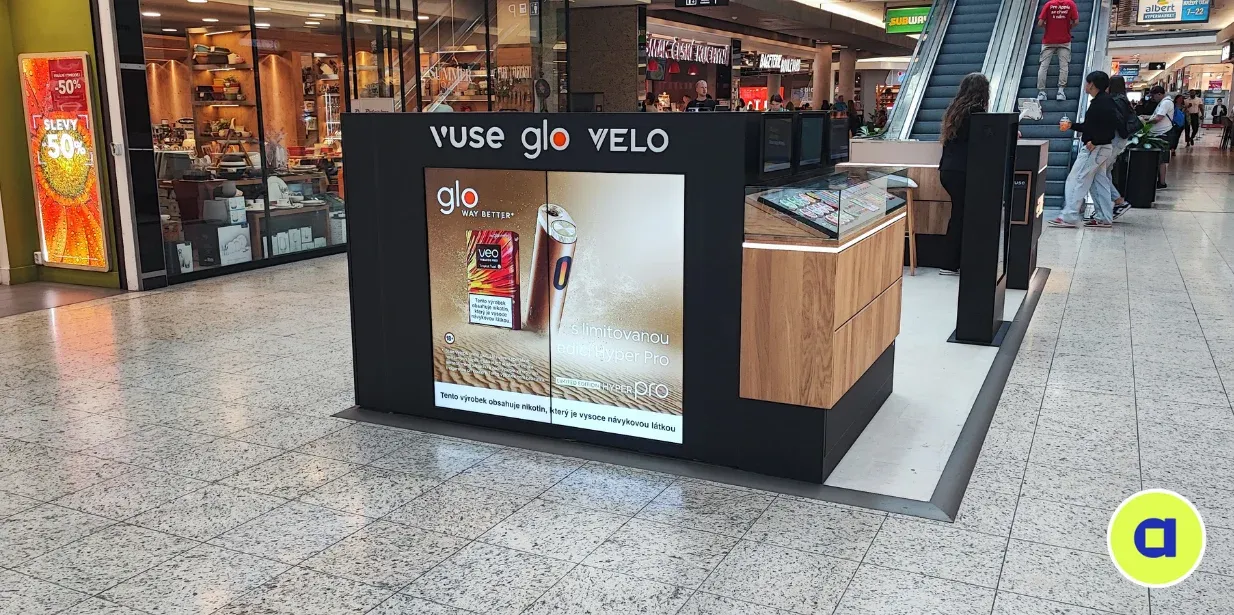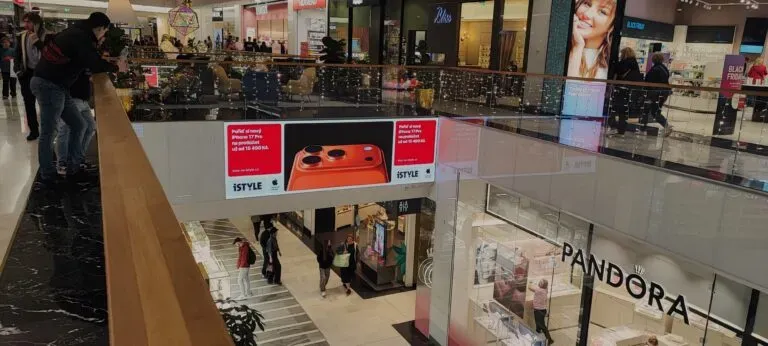Forecast for the development of digital advertising technologies until 2027
The world of digital advertising is rapidly changing.
Thanks to a diversity of digital advertising formats, it offers businesses and marketers new prospects for increasing effectiveness. The use of modern platforms is growing, providing broad opportunities for interactive communication and supplementing traditional marketing channels with innovative ideas. Today, advertising campaigns are becoming more personalized, and brands are searching for ways to maximize audience engagement with the help of future technologies.
Key trends in digital advertising technologies
The growing popularity of programmatic advertising
One of the leading trends is the widespread implementation of programmatic advertising, especially in the DOOH and programmatic DOOH segments. These tools open up possibilities for automated selection and placement of content, using pDOOH platforms that work based on algorithms and machine learning. This allows the effectiveness of each advertising impression to be increased, campaign spending to be better managed, and maximum accuracy to be achieved in reaching the target audience.
Development of artificial intelligence (AI)
The modern digital advertising market is actively integrating AI to analyze user behavior and predict their needs. The use of artificial intelligence helps tailor advertising messages to the interests and life context of consumers. This solution is especially effective for digital signage systems because digital signage software can change content on the fly depending on the audience. This significantly increases the level of personalization and makes advertising truly relevant.
Strengthening the role of mobile devices
Smartphones and tablets have become the primary platform for receiving digital content. Modern advertisers are adapting their campaigns to mobile platforms, using geolocation and contextual information. The flexibility in managing the digital space allows brands to reach a wider audience, organically integrate online and offline interaction, and instantly respond to user behavioral changes.
Interactive and immersive formats
Video advertising, as well as augmented (AR) and virtual (VR) reality technologies, are being used more and more often in digital signage to create an engaging and memorable experience. Digital signage software makes it possible to implement complex scenarios of interactive interaction, attracting the audience to active dialogue with the brand. Such formats contribute to increased recognition and foster a positive emotional connection between the company and the consumer.
Social networks as the main channel for digital advertising
Modern social networks remain the leading channel of communication between brands and consumers. Thanks to the development of targeting algorithms, digital advertising on Facebook, Instagram, or TikTok enables companies to determine their audience with extraordinary precision by interests, behavior, age, and even geography. By adding integration with Digital Signage systems or digital menu boards, brands can provide full omnichannel interaction with customers, with messages easily scaled both in physical and digital spaces.
More and more businesses are implementing a digital menu in the social networks of their establishments: up-to-date offers are updated daily and delivered directly to the user. This allows attention to be retained from regular customers and attracts new ones through personalized advertising campaigns. Let us take a look at what innovations already exist in the field of digital advertising.
Augmented reality (AR) in advertising
The use of AR technologies is bringing revolutionary changes to digital advertising and audience interaction. Thanks to the possibility of integrating digital objects into the surrounding environment through a smartphone camera, a customer can try on accessories in real time, view furniture inside their own apartment, or examine other virtual products. Such technologies are used not only in mobile applications, but also in digital menu boards, which display interactive content in restaurants and cafes.
The implementation of AR complements the work of Digital Signage systems: for example, digital menus can display 3D-animations of dishes or drinks. This increases visitor engagement, makes advertising unique, and helps establishments stand out among competitors.
Virtual reality (VR) for brand activations
VR technologies allow brands to create unique emotional experiences, immersing the audience in a virtual world of the product. With the help of VR, virtual tours of stores, presentations of new products, or even complete events accessible from anywhere in the world can be organized. This opens up new possibilities for engaging customers regardless of their physical location.
VR activations can easily be combined with Digital Signage systems, creating the effect of complete presence. A modern player for digital signage makes it possible to broadcast VR content in sales areas or open spaces, providing a comprehensive and impressive advertising experience.
Voice assistants and smart speakers
The realities of today’s digital world define a new trend—interaction with brands via voice. More and more companies are optimizing their offerings for voice assistants: Google Assistant, Alexa, or Siri. Thanks to these services, consumers can inquire, order, or learn about products simply by using their voice, without physically interacting with the device.
An indoor audio player helps integrate voice messages, advertisements, or announcements in shopping areas, offices, and cafes. Such solutions provide a new level of personalized communications and can work in conjunction with digital screens and menus.
Smart screens and digital signage
Digital screens and modern Digital Signage systems are changing the approach to presenting information and advertising in public spaces. Equipped with sensors and cameras, such screens analyze the audience—gender, age, weather, and time indicators—and automatically adjust content to deliver the advertising message as relevantly as possible.
The advantages of digital advertising in this format are especially noticeable in restaurants, cafes, and shopping centers, where digital menu boards are updated in real time. A digital signage player quickly switches menus or promotional offers, allowing for prompt responses to changes in demand or the market situation. This provides maximum flexibility and efficiency for advertising strategies.
Impact of digital advertising on sales and advantages over traditional channels
According to a Nielsen study, using digital signage in retail stores can increase sales by up to 33% thanks to dynamic content formatting and flexible management of current offers. A Digital Signage Today survey notes that 83% of shoppers remember digital advertising better than static banners or print graphics. Moreover, according to data from FedEx Office and other research, brands implementing digital menus or menu boards record an increase in unplanned purchases in 8 out of 10 cases, with the average transaction rising by 3–20%.
Comparison with print, OOH, and television
Statista analytics indicate that in 2024, 71% of marketers worldwide prefer digital advertising due to its targeting accuracy, transparent measurement, and real-time campaign adjustment capability. In traditional media (print, OOH, TV), ROI is difficult to track, while in digital it can be measured in real time and is significantly higher: for example, Google Ads offers an average ROI of over 800%.
Most studies by the Out of Home Advertising Association of America show that digital OOH displays get four times more views than static signs, and recall of such advertising is 60–80% higher.
Budget trends and market dynamics
According to eMarketer forecasts, investment in digital advertising will reach $870 billion by 2027, meaning over 73% of the global advertising budget will be directed to digital channels. WARC Global Advertising Trends research confirms that the DOOH segment is growing 17% annually, and by 2028 its share in the total US OOH market will exceed 31%.
Direct business benefit
According to Samsung Insights, the use of digital menus and digital signage enables businesses to reduce marketing expenses by 30–50% through automation and more efficient content management. A Pepsi study showed that after implementing digital screens at points of sale, sales increased by 17%, and customer loyalty levels improved.
Blockchain in advertising
The introduction of blockchain technologies into the advertising business is changing approaches to campaign placement and monitoring. A decentralized digital ledger ensures absolute transparency of all transactions and interactions, which is especially important for centralized video management systems operating across numerous advertising screens. With blockchain, advertisers can be certain that every interaction with content is recorded accurately—from display on Android media players to engagement via Digital Signage. This approach is particularly effective for combating fraud: platforms can easily detect bots, log only real views, and register genuine ad clicks, which positively influences trust between advertisers and publishers.
Blockchain also enables automated payments among advertising market participants through smart contracts. This can significantly reduce intermediary commission costs and speed up financial operations, especially when campaigns cover different Digital Signage platforms, CMS, or Android set-top boxes. In systems using Digital Signage solutions, blockchain helps maintain an immutable record of all user actions, optimize expenditures, and improve video content management efficiency.
Practical applications of innovative technologies
AR in retail
Augmented reality is being actively implemented by retailers as a way to increase engagement and sales. For example, in cosmetics stores, CMS integrations allow customers to “try on” makeup in real time via a smartphone camera. Advertising screens and Digital Signage solutions in sales areas become platforms for interactive experiences: by scanning a QR code from a digital screen, the shopper instantly receives a personalized AR product try-on. According to industry observations, AR technologies significantly increase the duration of engagement with a brand and the number of products tested—by 7.5 times more than without AR.
A comprehensive CMS for Digital Signage allows such services to be deployed across all advertising screens in the network and even on individual Android media players. This creates a seamless interactive experience for both retail and educational or image-building campaigns.
VR for the automotive industry
Virtual reality is opening fundamentally new approaches to interaction in auto sales. Well-known automakers are implementing VR technologies both for internal design and for presenting their cars to customers. Through VR tours or test drives, a potential client can immerse themselves in a virtual environment where they experience driving a vehicle in different conditions. Such VR zones are equipped with advertising screens, and content is easily managed by a centralized video control system configured for updates and integration with Android media players. This approach not only shortens the decision-making time but also increases the effectiveness of showcasing new models.
Voice assistants in e-commerce
Online stores are increasingly integrating voice interfaces into their business models. Modern Digital Signage solutions can be supplemented with voice control functionality—for example, via an Android set-top box or a special media player, it is possible to activate voice navigation through the catalog or receive personalized recommendations. According to forecasts, by 2025 the volume of transactions using voice in global e-commerce will exceed $164billion, and the introduction of voice technologies noticeably simplifies the process of ordering goods and accelerates product search.
Within large retail chains, centralized video control systems can not only broadcast advertising on screens but also “listen” to commands aimed at obtaining additional information or placing orders, increasing the personalization of interaction.
Advision — Content Management System for remote management, media planning of video and audio content broadcasting and Supply-Side Platform for monetization of advertising time. We help Digital Signage owners and DOOH advertising operators earn on advertising placement, automate workflows and build a reliable media infrastructure using our own software solutions.
Contact us if you want to increase your profit and implement the most modern technologies to solve problems!




















